«Images» tab¶
This manages images of the Glance service. Instance images are represented by list:
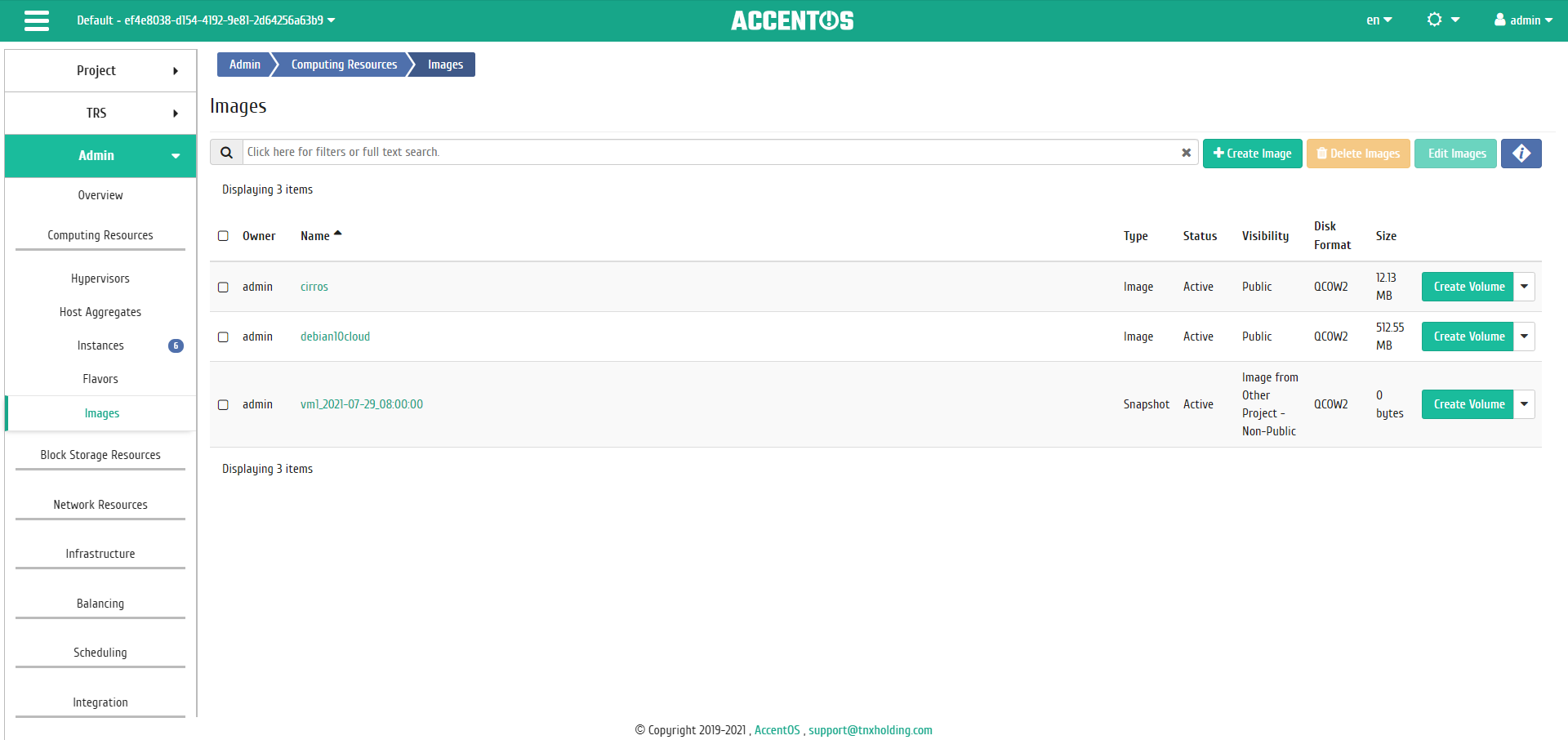
Images list¶
| Field name | Description |
|---|---|
| Owner | Project that owns the image or snapshot. |
| Name | Name of the image or snapshot given by the user when it was created. This is also a link to go to details about this image. |
| Type | There are the following:
|
| Status | Image status. |
| Visibility | This parameter displays whether the image or snapshot is public. Public ones are available to everyone, private ones - only within the project in which they were created. |
| Disk Format | Image format. There are the following:
|
| Size | Size of the image or snapshot depends on the volume or instance from which the image or snapshot is created, set when it is created. |
Sorting and filtering tools are available for the list of images. The fields are sorted in ascending and descending order. It is also possible to sort the objects marked with check mark. Filtration is performed according to the following parameters:
- Owner is project that owns the image or snapshot. Incomplete input is allowed;
- Name of the image or snapshot. Incomplete input is allowed;
- Status of the image or snapshot. Incomplete input is allowed;
- Visibility of the image or snapshot. Incomplete input is allowed;
- Image or snapshot format. Incomplete input is allowed;
- Minimum size (bytes) is the minimum value for the size of an image or snapshot. Incomplete input is allowed;
- Maximum size (bytes) is the maximum value for the size of an image or snapshot. Incomplete input is allowed;
- Protected (image or snapshot protection). Incomplete input is allowed.
| N | Action | Description |
|---|---|---|
| 1 | Create image | Create an image with the specified parameters:
|
| 2 | Create volume | Creating volume from the selected image or snapshot with the specified parameters. |
| 3 | Edit image | Changing the parameters of the created image or snapshot. |
| 4 | Update Metadata | Image metadata management.” |
| 5 | Delete image | Deleting an existing image or snapshot. |
Actions are available for execution relative to one selected image - by selecting the desired action in the field «Actions» of the corresponding line in the list of all images.
You can also perform operations on a group of preselected images. To do this, you need to mark the necessary images and select group action:
Features of working with images¶
Image creating¶
In the general list of all images on the control panel using the «Create Image» button, open the image creation wizard:
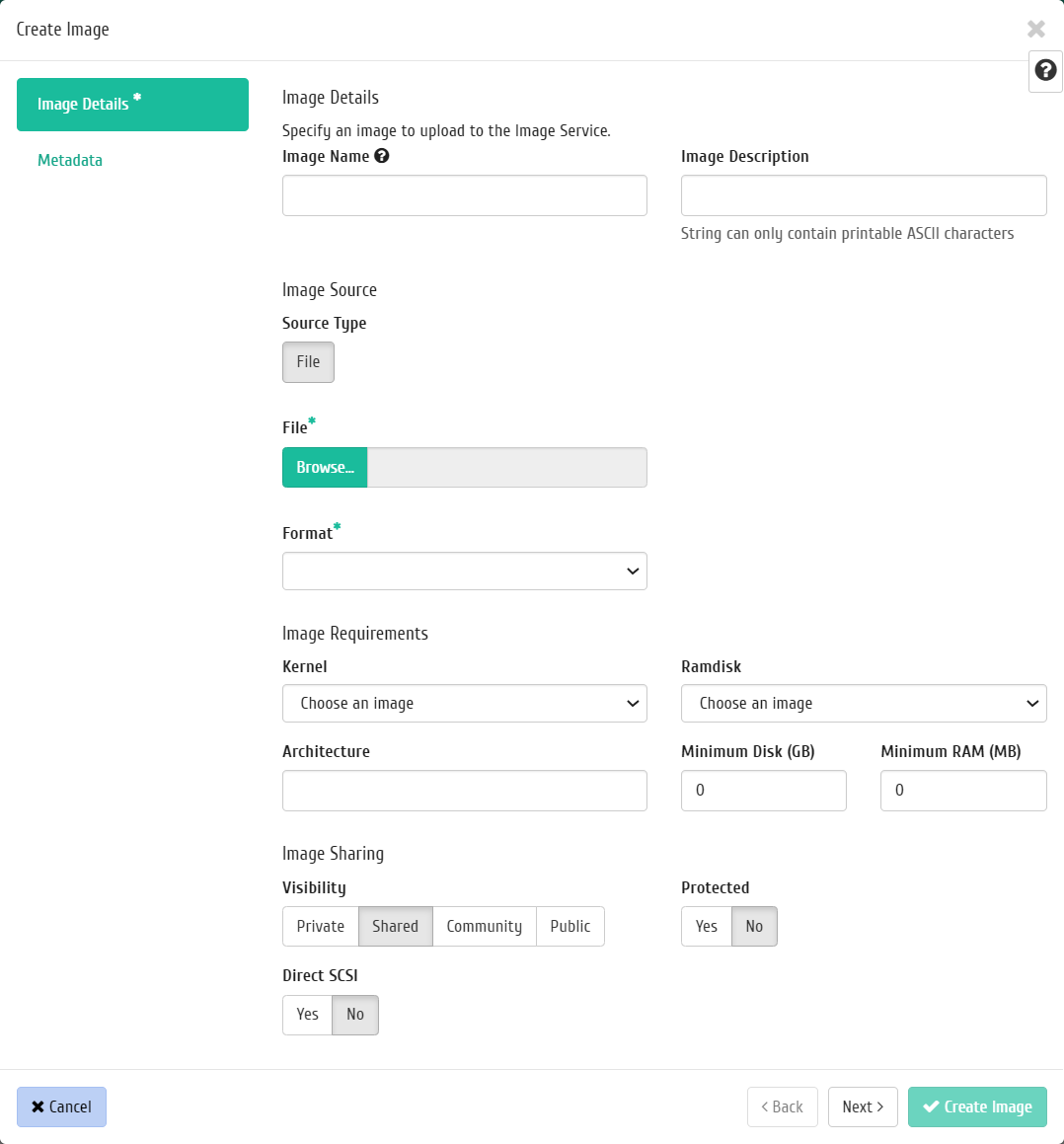
Image creation window¶
In the window that opens, indicate:
Image name, optional field, if the value is empty, the name is generated automatically;
Image description in the format ASCII, optional parameter;
Source type, select the type of download source:
- Files.
File is internal address of the image, which is located locally on the system.
Format, select image format from the list of available:
- AKI is Amazon Kernel image;
- AMI is Amazon Machine image;
- ARI is Amazon Ramdisk image;
- Docker is Docker container;
- ISO is optical disk image;
- OVA is Open Virtual Appliance;
- QCOW2 is QEMU image;
- RAW is RAW format unstructured disc;
- VDI is virtual disk image;
- VHD is virtual hard disk;
- VMDK is virtual machine disk;
- PLOOP is loop disc.
Required parameter;
Kernel, select the kernel for the image. Only images of individual formats can be used, in the absence of which the field is not displayed;
Disk In Memory, select disk from memory;
Architecture, architecture of the image;
Minimum disk size is required to download the image. Default value is 0 (GB);
Minimum memory size is required to download the image. Default value is 0 (MB);
Visibility is the visibility of an image. Available values are:
- Shared;
- Community;
- Public;
- Private.
Protected, image protection. Available values are:
- Yes;
- No.
Direct SCSI is activation of Direct SCSI mode. Available values are:
- Yes;
- No.
Metadata, image metadata options.
Image editing¶
Function allows to change the parameters of the created image.
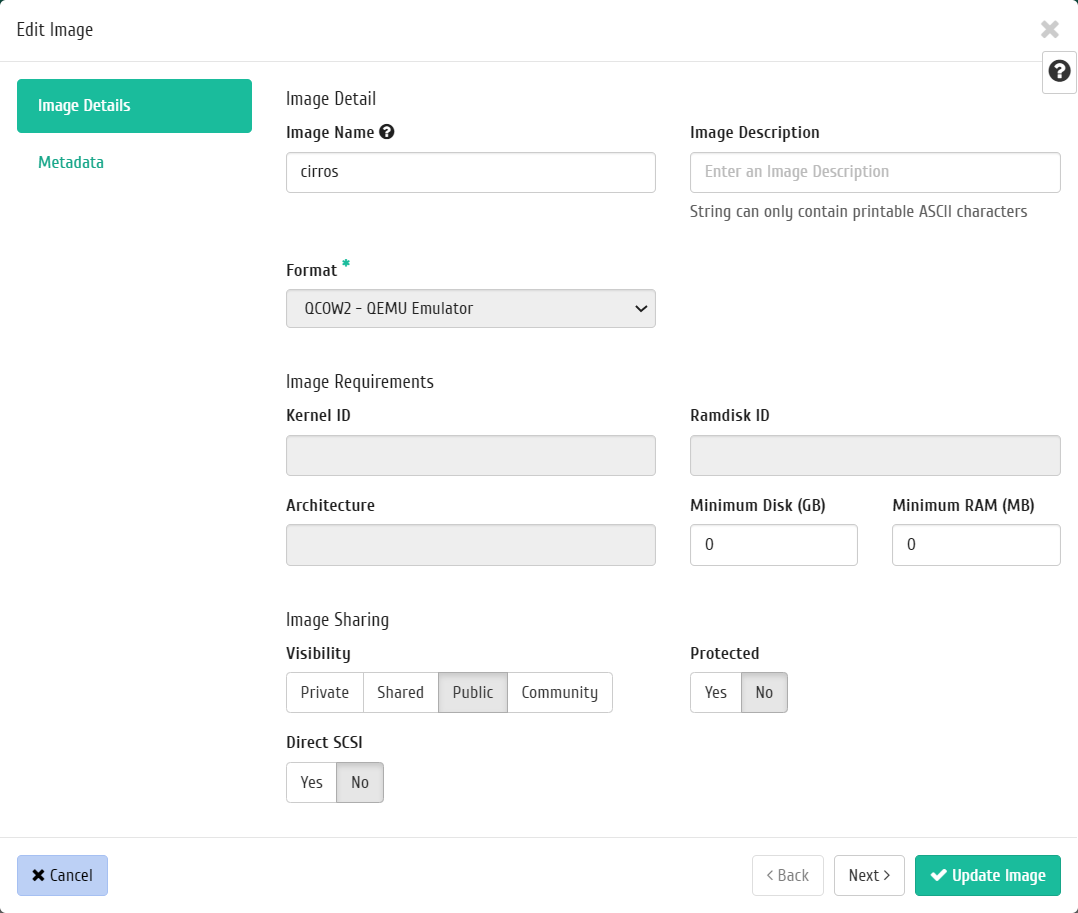
Window for changing image parameters¶
Group editing of images¶
Function is available on the top panel in the general list of all images. Select required ones and call the action «Edit images». In the window that opens, set parameters for the selected images:
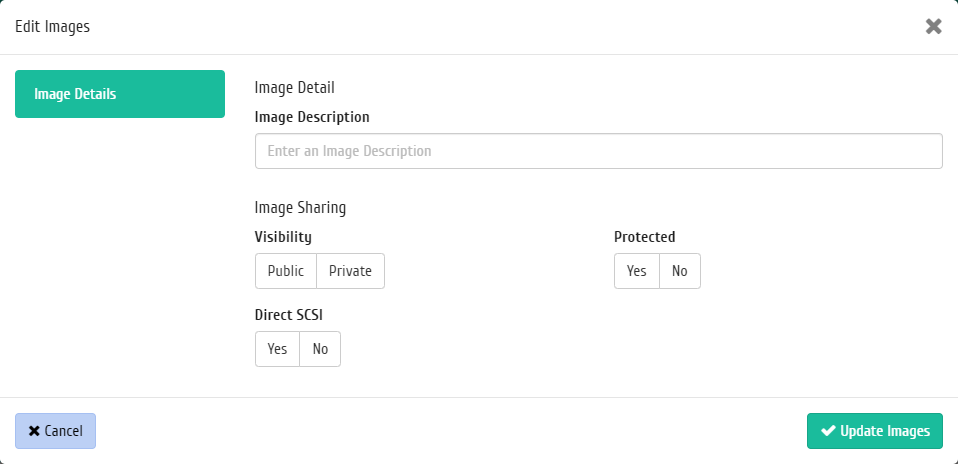
Window for changing image group parameters¶
Function allows to change following parameters:
- Image description is optional parameter;
- Visibility is the visibility of image. Available values are:
- Public;
- Private.
- Protected, the presence of this flag prohibits changing, copying and deleting images;
- Direct SCSI, selection this flag activate of Direct SCSI mode.
Complete the editing procedure with the confirmation button.
Image metadata updating¶
Function allows to manage the image metadata. It is available in the general list. After calling the action in the window that opens, set necessary parameters:
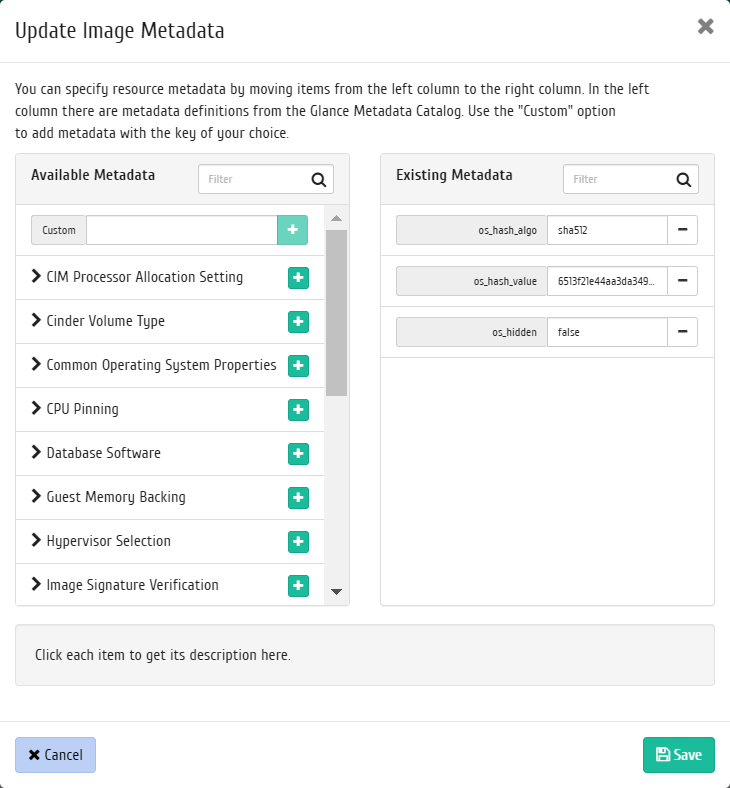
Image metadata change window¶
Parameters are divided into two groups: «Available metadata» and «Existing Metadata». Filtering tool is available for lists. Metadata management is carried out by buttons in the form of plus and minus.
To add new metadata use the option «Custom», input required key in the format ASCII and add it to the existing.
Complete the procedure with the button «Save».
Viewing image detailed information¶
Also, the user can view detailed information about the image. Detailed information about the object opens in a separate block on the right side of the page when you click on the image name link. This does not close the list of objects and is displayed on the left side of the page. To close block of detailed information use the  button, to open a block of detailed information use the button
button, to open a block of detailed information use the button  .
.
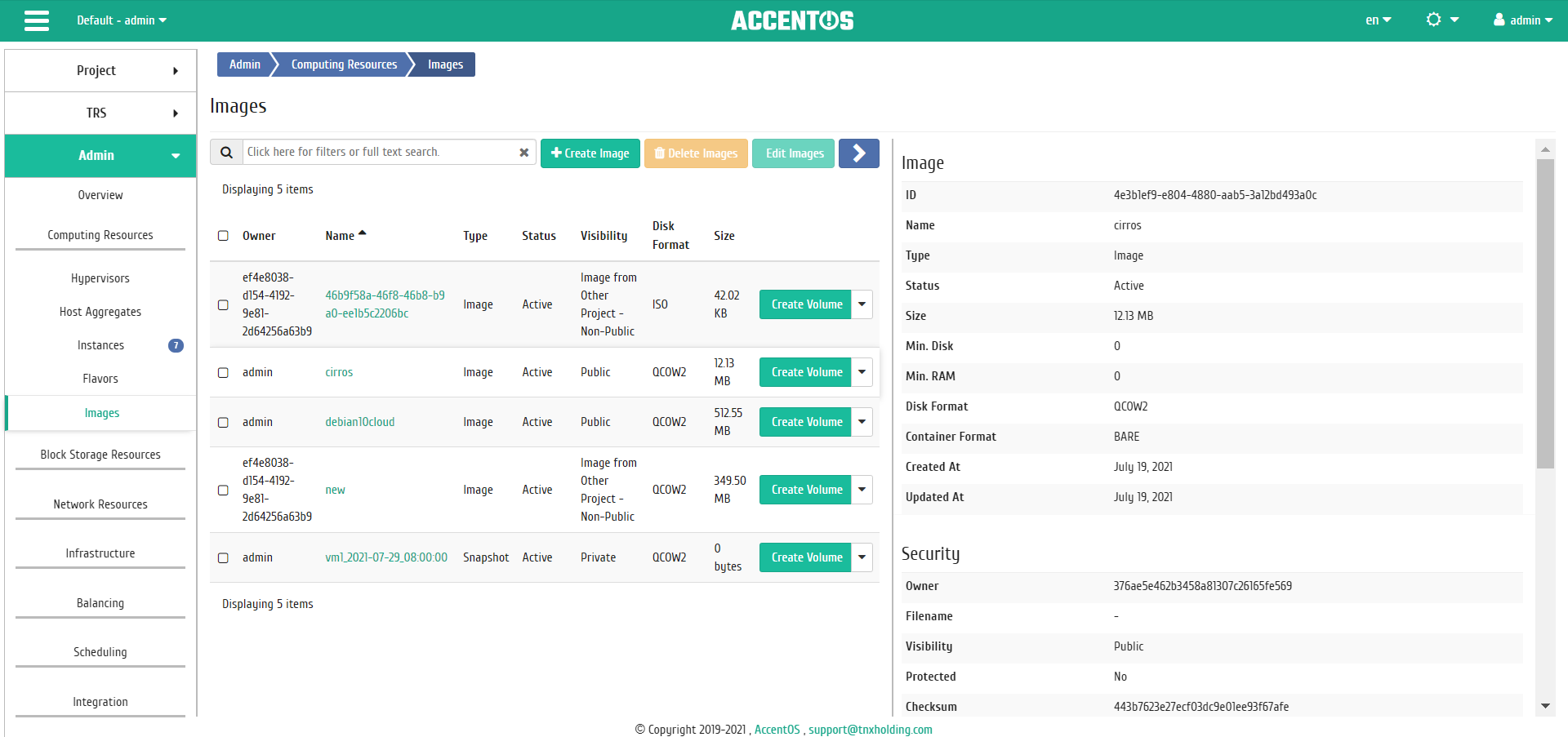
Details of the image¶